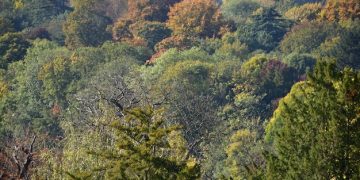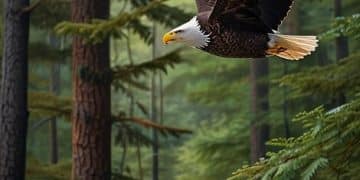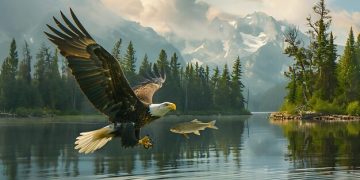Mitigating Climate Change Effects: Key Strategies for US Wildlife
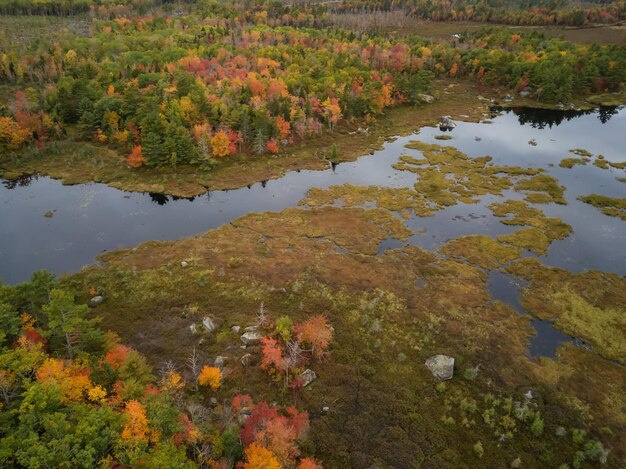
Key strategies for mitigating the effects of climate change on US wildlife include habitat preservation and restoration, reducing carbon emissions, managing water resources, addressing invasive species, and implementing adaptive management plans that consider future climate scenarios.
Climate change presents a significant threat to the diverse wildlife inhabiting the United States. Rising temperatures, altered precipitation patterns, and increased frequency of extreme weather events are already impacting ecosystems and pushing many species to the brink. Understanding what are the key strategies for mitigating the effects of climate change on US wildlife is crucial for safeguarding biodiversity and ensuring the long-term health of our natural environments.
Understanding Climate Change Impacts on US Wildlife
Climate change is no longer a distant threat; its effects are being felt across the United States, impacting habitats and wildlife populations. From rising sea levels threatening coastal ecosystems to increased wildfires devastating forests, the consequences are far-reaching. Understanding the specific ways in which climate change affects US wildlife is the first step in developing effective mitigation strategies.
Habitat Loss and Fragmentation
One of the most significant impacts of climate change is the alteration and destruction of habitats. As temperatures rise and precipitation patterns shift, ecosystems are forced to adapt, often leading to habitat loss and fragmentation. This can isolate wildlife populations, reducing genetic diversity and making them more vulnerable to extinction.
Changes in Species Distribution
Many species are shifting their ranges in response to climate change, seeking areas with more suitable temperatures and resources. This can lead to increased competition with native species and disrupt established ecological relationships. Additionally, some species may be unable to migrate quickly enough to keep pace with the changing climate, leading to population declines.
- Rising sea levels threaten coastal habitats essential for shorebirds, sea turtles, and other marine life.
- Increased wildfires destroy forests and grasslands, displacing wildlife and reducing food availability.
- Changes in precipitation patterns alter wetland ecosystems, impacting amphibians, waterfowl, and other species that depend on these habitats.
- Ocean acidification harms marine life, particularly shellfish and coral reefs, which provide critical habitat for numerous species.
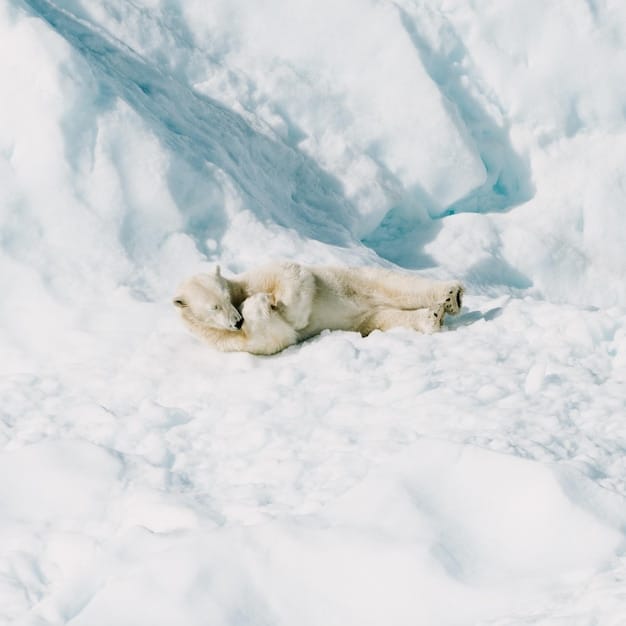
Understanding these specific impacts is crucial for developing targeted mitigation strategies. By addressing the root causes of climate change and implementing conservation measures, we can help protect US wildlife from the worst effects of a changing climate. It is important to recognize that these effects are interconnected and require comprehensive solutions. In fact, habitat loss exacerbates the spread of invasive species, further harming wildlife.
Preserving and Restoring Habitats
Habitat preservation and restoration are essential strategies for mitigating the effects of climate change on US wildlife. By protecting existing habitats and restoring degraded ecosystems, we can provide wildlife with the resources and space they need to adapt to a changing climate. This involves a range of approaches, from establishing protected areas to implementing sustainable land management practices.
Establishing Protected Areas
Creating and expanding protected areas, such as national parks, wildlife refuges, and wilderness areas, is a crucial step in preserving habitats. These areas provide safe havens for wildlife, protecting them from development, resource extraction, and other threats. They also serve as important reference points for monitoring the effects of climate change on ecosystems.
Restoring Degraded Ecosystems
Restoring degraded ecosystems, such as wetlands, forests, and grasslands, can enhance their ability to support wildlife and provide valuable ecosystem services. This involves a range of activities, from planting native vegetation to removing invasive species to restoring natural water flows.
- Reforestation can help sequester carbon dioxide, reduce soil erosion, and provide habitat for a variety of wildlife species.
- Wetland restoration can improve water quality, reduce flood risk, and provide critical habitat for waterfowl, amphibians, and other aquatic species.
- Grassland restoration can enhance biodiversity, improve soil health, and support grazing animals and pollinators.
These habitat restoration efforts require a collaborative approach, involving government agencies, non-profit organizations, and private landowners. Strategic partnerships are essential for maximizing the impact of these initiatives and ensuring the long-term success of conservation efforts. Ecosystem restoration can also improve water and air quality, therefore enhancing not only wildlife health but that of the general population too.
Reducing Carbon Emissions
Addressing the root cause of climate change by reducing carbon emissions is paramount to protecting US wildlife. Transitioning to a clean energy economy, improving energy efficiency, and promoting sustainable transportation are all essential strategies for mitigating climate change and its impacts on wildlife.
Transitioning to a Clean Energy Economy
Shifting away from fossil fuels and investing in renewable energy sources, such as solar, wind, and geothermal power, can significantly reduce carbon emissions. This transition will require policy changes, technological innovation, and public support.
Improving Energy Efficiency
Improving energy efficiency in buildings, transportation, and industry can also reduce carbon emissions. This involves using more efficient appliances, improving insulation in homes and buildings, and promoting the use of public transportation, walking, and cycling.
- Investing in energy-efficient technologies can reduce energy consumption and lower carbon emissions.
- Promoting sustainable transportation can reduce reliance on fossil fuel-powered vehicles and improve air quality.
- Adopting sustainable building practices can reduce energy consumption and minimize the environmental impact of construction.
These efforts to reduce carbon emissions must be implemented at all levels, from individual actions to international agreements. By working together to reduce our carbon footprint, we can protect US wildlife from the worst effects of climate change and create a more sustainable future for all. Many companies have shifted to renewable energy. This has not only helped the environment but also improved their revenue.
Managing Water Resources
Climate change is altering water availability and increasing the frequency of droughts and floods, impacting wildlife populations across the United States. Effective water management is crucial for mitigating these impacts and ensuring that wildlife have access to the water resources they need to survive.
Conserving Water Resources
Conserving water resources through efficient irrigation practices, water-saving technologies, and responsible water use can help maintain adequate water supplies for wildlife. This involves implementing policies and practices that encourage water conservation and reduce water waste.
Restoring Water Flows
Restoring natural water flows to rivers, streams, and wetlands can improve habitat conditions for wildlife and enhance their resilience to drought. This involves removing dams, restoring stream channels, and implementing water management strategies that prioritize ecological needs.
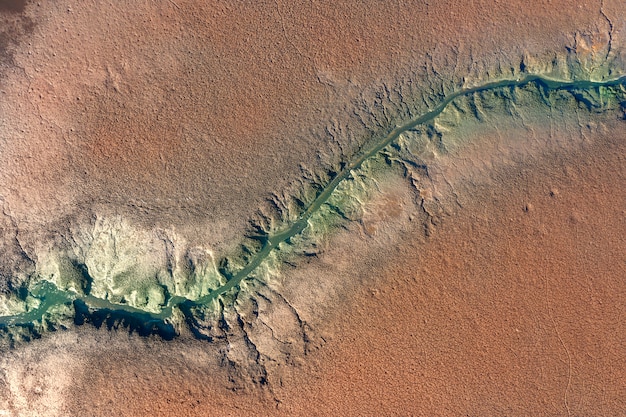
- Implementing water-efficient irrigation practices can reduce water consumption in agriculture and free up water for wildlife.
- Restoring riparian habitats can improve water quality, provide shade, and create corridors for wildlife movement.
- Managing stormwater runoff can reduce pollution and improve water availability for aquatic species.
These water management strategies require a coordinated approach, involving government agencies, water managers, and local communities. By working together to conserve and restore water resources, we can help protect US wildlife from the impacts of climate change and ensure the long-term health of our ecosystems. Ultimately, this requires a complete alteration of water use and human activity in certain regions.
Addressing Invasive Species
Climate change can exacerbate the spread of invasive species, which can outcompete native wildlife for resources and alter ecosystem dynamics. Managing invasive species is crucial for mitigating their impacts on US wildlife and maintaining healthy ecosystems. Native plants, for example, can be vulnerable to invasive plants that dominate territory.
Preventing the Introduction of Invasive Species
Preventing the introduction of new invasive species is the most effective way to manage their impacts. This involves implementing strict biosecurity measures, controlling ballast water in ships, and educating the public about the risks of introducing non-native species.
Controlling Existing Invasive Species
Controlling existing invasive species through targeted removal efforts, biological control, and habitat restoration can help reduce their impacts on native wildlife. This requires a sustained commitment and a range of approaches tailored to specific species and ecosystems.
- Implementing early detection and rapid response programs can prevent invasive species from becoming established.
- Using biological control agents, such as insects or pathogens, can help control invasive plant and animal populations.
- Engaging volunteers in invasive species removal efforts can increase the effectiveness and reach of management programs.
These invasive species management strategies require a collaborative approach, involving government agencies, non-profit organizations, and private landowners. By working together to prevent and control invasive species, we can help protect US wildlife and maintain the integrity of our ecosystems. Constant monitoring of invasive species is important to detect and address the spread of these species.
Implementing Adaptive Management Plans
Given the uncertainty surrounding future climate change impacts, implementing adaptive management plans is crucial for protecting US wildlife. Adaptive management involves monitoring the effects of climate change on wildlife populations and ecosystems, evaluating the effectiveness of conservation strategies, and adjusting management approaches as needed. Adaptive management involves flexibility and requires managers to adjust their actions and decisions to achieve common conservation goals.
Monitoring Climate Change Impacts
Monitoring climate change impacts on wildlife populations and ecosystems provides valuable data for assessing the effectiveness of conservation strategies and informing management decisions. This involves tracking changes in species distribution, population size, habitat condition, and other key indicators.
Evaluating Conservation Strategies
Evaluating the effectiveness of conservation strategies is essential for ensuring that they are achieving their intended goals. This involves collecting data on the outcomes of conservation actions and using this data to refine management approaches.
- Developing climate-resilient conservation strategies can help wildlife adapt to a changing climate.
- Using predictive models can help anticipate future climate change impacts and inform management decisions.
- Promoting collaboration and information sharing can improve the effectiveness of adaptive management efforts.
These adaptive management strategies require a commitment to continuous learning and improvement. By embracing flexibility and adaptivity, we can ensure that our conservation efforts are effective in protecting US wildlife in the face of climate change. A key benefit of adaptive management includes the use of various models to consider possible scenarios and anticipate uncertain change.
| Key Strategy | Brief Description |
|---|---|
| 🌳 Habitat Preservation | Protecting existing natural areas to provide safe havens for wildlife. |
| 🌍 Carbon Reduction | Lowering emissions through renewable energy and improved efficiency. |
| 💧 Water Management | Conserving and restoring water resources for wildlife needs. |
| 🛡️ Invasive Control | Managing and preventing the spread of harmful non-native species. |
Frequently Asked Questions
▼
The foremost threats encompass habitat reduction, shifts in species territories, and amplified occurrences of harsh weather events like droughts, wildfires, and floods. All these put immense strain on ecosystems.
▼
Habitat restoration can enhance the ability of ecosystems to support wildlife as well as provide valuable services. Actions such as reforesting improve carbon sequestration and improve the overall environment.
▼
Decreasing carbon releases tackles the primary cause of global warming. Shifting to renewable power sources and enhancing energy efficiency can considerably alleviate the impacts to wildlife and their habitats.
▼
Effective water control is vital as climate change alters water accessibility. This entails conserving water, restoring water flow, and executing strategies to ensure there’s adequate water available for animal life.
▼
Invasive varieties can outcompete local wildlife and change ecosystems. Handling or managing these involves safeguarding indigenous species and preserving ecosystems from the damaging consequences brought by non-native entrants.
Conclusion
Protecting US wildlife from the effects of climate change requires a multifaceted approach that addresses both the symptoms and the root causes of this global challenge. By implementing the key strategies outlined above, we can enhance the resilience of ecosystems, reduce carbon emissions, manage water resources sustainably, control invasive species, and promote adaptive management practices. While this is by no means a simple task, it is essential to preserve native wildlife.
